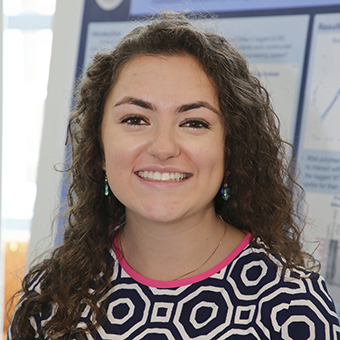Sabrina McDonnell
 Hedstrom Laboratory
Hedstrom Laboratory
Department of Biology
Brandeis University
Exploring the Function of IMPDH’s CBS Domain in Escherichia Coli
Poster Abstract
Inosine 5’-monophosphate dehydrogenase (IMPDH) converts inosine 5’-monophosphate (IMP) to xanthosine 5’-monophosphate (XMP), as a part of the de novo purine biosynthesis pathway. IMPDH is a tetramer, and each monomer has two domains: a catalytic domain and a cystathionine β-synthase (CBS) domain. The function of the CBS domain is currently unknown. However, the enzyme remains catalytically active when the CBS domain is replaced with a short peptide scar (ΔCBS). Mutations in the CBS domain of human IMPDH have been linked to hereditary diseases including, but not limited to retinitis pigmentosa. Understanding the function of the CBS domain in E. coli will shed light on IMPDH’s moonlighting functions. Previous research in the Hedstrom Laboratory suggests that IMPDH interacts with both RNA Polymerase Beta (RNAPB) and Ribosome. E. coli strains expressing Strep-II tagged IMPDH and ΔCBS IMPDH were constructed, and affinity purification was used, to test for the presence of these interactions. A western blot containing fractions from a Strep-II tagged wild type lysate failed to confirm any interaction between IMPDH, RNAPB and Ribosome. During subsequent experiments, formaldehyde cross-linking was used to chemically crosslink protein-protein and protein-DNA/RNA interactions prior to purification. The formaldehyde cross-linking experiment revealed possible binding partners, but the protocol still needs to be optimized. Once cross-linking conditions are optimized, samples will be sent for mass spectrometry to identify the protein(s) interacting with IMPDH.
Personal Statement
In high school, I developed a passion for science, but my school’s limited resources prevented me from getting involved in bench research. When I started at Brandeis and decided to study biochemistry, I knew I wanted to work in a lab and explore the multitude of research opportunities available on campus. I used my first year at Brandeis to become accustomed to the rigorous demands of college level science courses, and prior to my sophomore year, I reached out to Professor Liz Hedstrom. I was interested in the work in developing new antibiotics, so I was thrilled when she brought me in for an interview and gave me a position in her lab. Senior Daniel Kats ’16 demonstrated lab techniques and taught me the fundamentals I needed to complete basic scientific research. By the end of the year, I had acquired the skills to conduct experiments independently. I then applied for and received the Division of Science Summer Undergraduate Research Fellowship. My first summer taught me about my abilities as a scientist and showed me how challenging and rewarding research can be. Scientific research rarely goes according to plan, but each failure provides insight into an aspect of the project that has not been understood.
After completing a year of research for course credit, I applied again for summer funding and was fortunate enough to become an M.R. Bauer Fellow. The support I received enabled me to delve deeper into my project and become more confident in my abilities as a researcher. This summer I accomplished a great deal and moved closer to answering my research questions. Having the opportunity to work in a lab over the past two years has taught me many valuable lessons, including patience and perseverance.